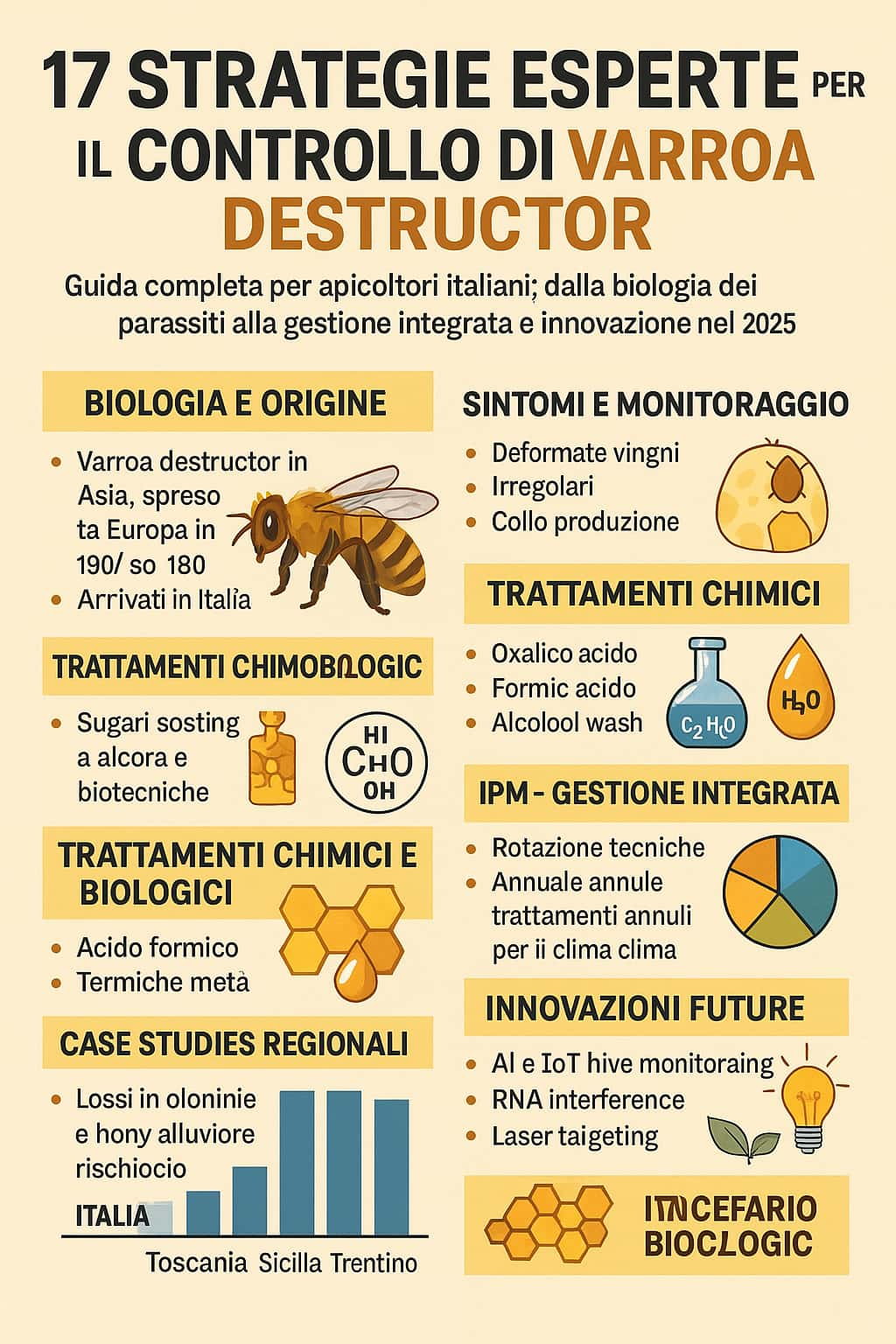17 Expert Strategies for Varroa Destructor Control
17 Expert Strategies for Varroa Destructor Control
A Complete Guide for Italian Beekeepers: From Parasite Biology to Innovation in 2025
Introduction
Varroa destructor is the most dangerous enemy of Italian bees. This parasite weakens colonies and transmits destructive viruses. In this guide, we'll explore 17 proven strategies—including chemical, biological, IPM, genetics, and technological innovation—to effectively control it and ensure healthy hives by 2025.
1. Biology and Origin
Varroa destructor is native to Asia and has colonized the European honeybee Apis mellifera , feeding on its fatty tissue. This vital tissue is essential for detoxification, immunity, and winter survival. The parasite transmits viruses such as Deformed Wing Virus (DWV) , which cause deformed wings, poor honey production, and colony collapse.
2. Global and Italian diffusion
In the 1970s and 1980s, the mite reached Europe and was reported in Italy in 1990. Today, it is present throughout the peninsula, damaging hives from north to south. The only exception is Australia, which has contained it with strict biosecurity measures.
3. Symptoms and Monitoring
Infested bees show:
- Deformed wings and irregular brood
- Mites fall on sticky board bottoms
- Decline in honey production
- Weak colonies, especially in winter
4. Monitoring Techniques
- Powdered sugar test : non-lethal, quick and useful in spring/summer.
- Alcohol bath : precise but fatal for champion bees.
- Sticky board : analysis of natural shedding, ideal for the colder months.
Monitoring calendar in Italy
| Season | Method |
|---|---|
| Spring | Sugar every 30 days |
| Summer | Pre- and post-treatment alcohol |
| Fall | Sticky board + sugar |
| Winter | Vaporization with oxalic acid during the brood-free period |
5. Chemical Treatments
- Amitraz (Apivar): effective but should be alternated to avoid resistance.
- Flumethrin (Bayvarol): effective, but subject to emerging resistance.
- Oxalic acid: ideal in winter, minimal residues and high efficacy.
- Formic acid (MAQS): also acts in the brood, requires good ventilation.
- Thyme (Apiguard): compatible with organic beekeeping, effective above 15°C.
6. Biological and Biotechnical Methods
- Drone Brood Removal: Reduces parasite reproduction by up to 60%.
- Brood break with queen in cage: interrupts the mite's life cycle.
- Heat treatments (42°C): kill mites without harming bees.
- Essential oils (thyme, eucalyptus, wintergreen): used in strips or vaporizers to combat parasites.
7. IPM – Integrated Seasonal Approach
Integrated management allows you to alternate methods and optimize results based on the regions:
| Month | Intervention |
|---|---|
| March | Drone hatch removal |
| May | Queen monitoring and caging |
| July | Apiguard Application |
| October | Formic acid after honey harvest |
| December | Vaporization with oxalic acid in the absence of brood |
8. The Italian Context
Italy has microclimates that require targeted interventions: the north favors oxalic acid, the center prefers organic methods, and the south thermal and biological technologies. Italian law requires annual reports on Varroa, veterinary treatments, and residue control. Organizations such as UNAAPI and CONAPI provide training, IPM kits, and financial support.
9. Breeding of Resistant Bees
Hygienic bees with Varroa-sensitive hygiene (VSH) behavior have been selected by the CREA center and EU projects such as SmartBees and BEEBOOK. The goal is to obtain lines with natural defenses against mites.
10. Economic and Ecological Impacts
- Average cost per hive: €20–30/year
- Cologne replacement: €150–200
- Honey loss: up to 40%
- Pollination service: approximately €2 billion per year in Italy
- Biodiversity: Bees support native flora and fauna
11. Regional Case Studies
Tuscany
Thanks to coordinated IPM and drone brood removal, losses have dropped from 30% to 10%. IoT tools are now being tested for real-time monitoring.
Sicily
Mild climates encourage the use of thermal chambers, organic acids, and essential oils on a seasonal basis.
Trentino-Alto Adige
Synergy between sensors, oxalic acid and drone brood capture in an Alpine environment.
12. Innovations and Future Trends
- AI + IoT: 24/7 hive monitoring with infestation prediction.
- RNA interference (RNAi): experiments on Varroa genes.
- Laser targeting: projects to destroy mites in brood cells.
- Blockchain: Transparent treatment traceability and hive health.
13. Frequently Asked Questions (FAQ)
- Why is Varroa so difficult to eliminate?
- It reproduces in sealed brood and spreads between hives. Monitoring and treatment rotation are essential.
- Are organic treatments effective?
- Yes, if applied correctly and at the right time. Oxalic acid, formic acid, and essential oils work at the right times and do not contaminate honey.
- How often should bees be monitored?
- Spring to late summer: every 4–6 weeks. In winter, when the brood is absent, treat with oxalic acid.
- Why alternate treatments?
- Prevents the development of resistance in parasites and maintains product efficacy.
- Is there financial support?
- Yes: regional and EU funds cover monitoring, treatments, and genetic projects.
- What is the future for Varroa control?
- With IPM, genetics, and advanced technologies, beekeepers can coexist with Varroa while maintaining productive and healthy hives.






























